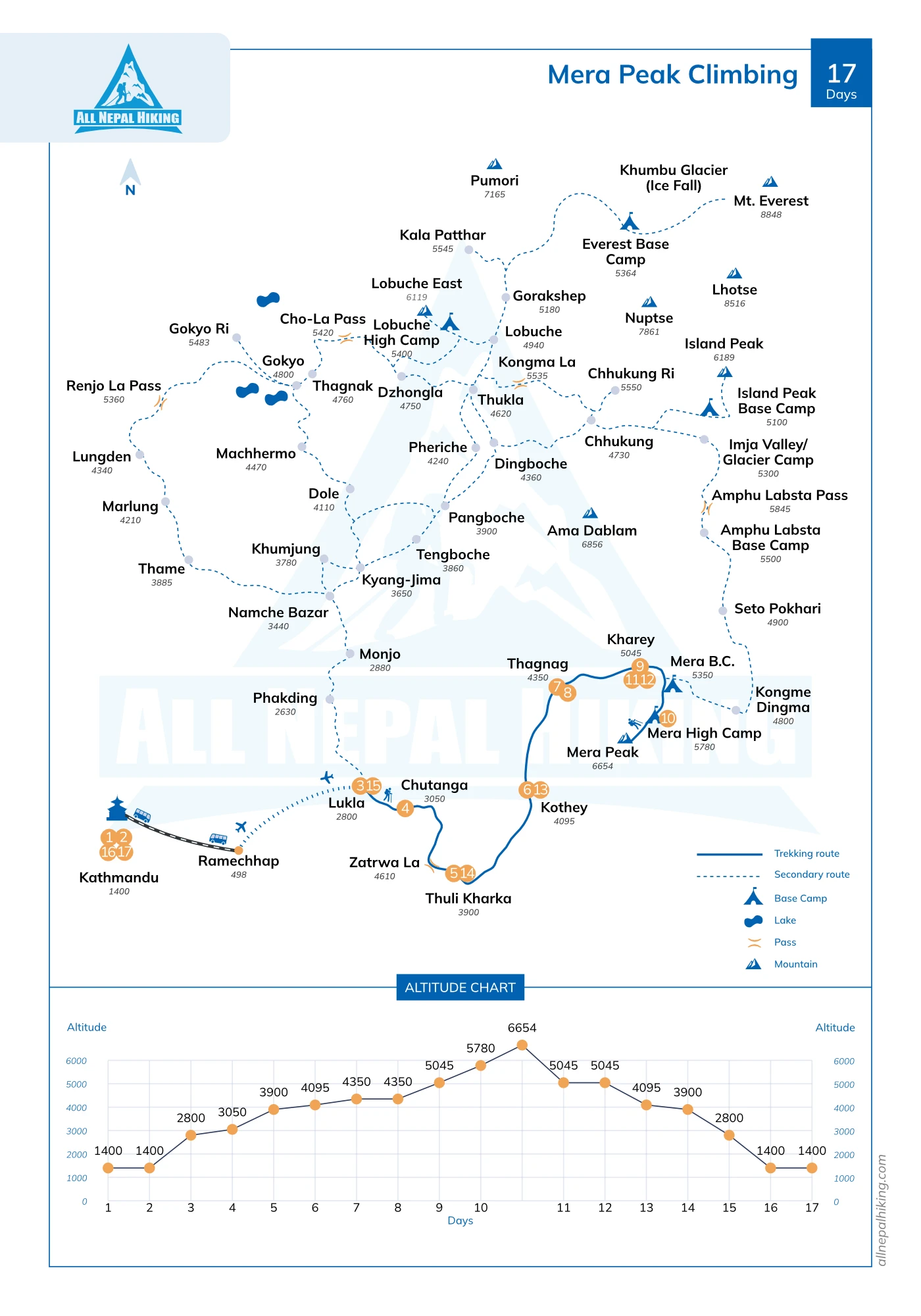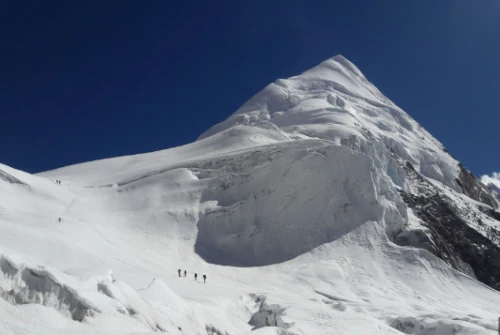Mera Peak Climbing Trip Overview
Mera Peak Climbing, at an impressive height of 6,461 meters (21,190 feet), is the highest trekking peak in Nepal and a premier destination for adventure seekers and mountaineers eager to experience the grandeur of the Himalayan mountains. Situated in the Solu Khumbu region within the renowned Mahalangur Himalayas, this expedition offers a perfect blend of breathtaking natural beauty, cultural richness, and moderate technical mountaineering challenges, making it accessible for trekkers with good fitness and basic climbing skills.
The route to Mera Peak traverses through the remote Hinku Valley and the Makalu Barun National Park, one of Nepal’s most pristine conservation areas, home to rare species such as the elusive red panda, musk deer, and diverse Himalayan birdlife, alongside vibrant rhododendron forests and alpine meadows that showcase the region’s extraordinary biodiversity. Trekkers are rewarded with panoramic, awe-inspiring views of five of the world’s highest peaks Mount Everest (8,848m), Lhotse (8,516m), Cho Oyu (8,201m), Makalu (8,485m), and Kanchenjunga (8,586m) from the summit of Mera Peak, offering one of the most spectacular vantage points in Nepal trekking.
Beyond the natural splendor, this expedition provides deep cultural immersion as climbers journey through traditional Sherpa villages such as Paiya, Panggom, and Khare, where they witness the distinctive Sherpa lifestyle, age-old Buddhist practices, prayer flags fluttering against the Himalayan backdrop, and the renowned Sherpa hospitality that has supported mountaineering for decades.
The Sherpa community’s history and resilience add a profound cultural dimension to the trek, enhancing the experience beyond just physical achievement. Historically, Mera Peak was first summited in 1953 and has since served as a vital training peak for mountaineers preparing for more technical Himalayan expeditions, including Mount Everest.
The route itself is thoughtfully designed to maximize acclimatization and safety, favoring the longer and scenic trek through Hinku Valley instead of the traditional Zatra La Pass route, allowing trekkers to gradually ascend and adjust to high altitudes, thus reducing risks associated with altitude sickness.
Starting with a thrilling domestic flight from Kathmandu to Lukla, the gateway to Everest and the Himalayas, trekkers follow well-marked trails passing through dense forests, river crossings, and mountainous terrains, spending acclimatization days in villages like Khare to rest and prepare for the demanding ascent.
The climb involves moderate technical challenges, including glacier crossings, snow slopes up to 40 degrees, and negotiating crevasses, requiring climbers to have fundamental mountaineering skills such as the use of crampons, ice axes, and rope techniques, which are taught during pre-summit training sessions by experienced Sherpa guides.
The optimal climbing seasons for Mera Peak are spring (March to May) and autumn (September to November), when the Himalayan weather is generally stable, skies are clear, and the views are breathtakingly clear, making these periods ideal for successful summit attempts. Throughout the journey, climbers not only test their endurance and skills but also enjoy the unparalleled natural beauty, the thrill of summiting Nepal’s highest trekking peak, and the chance to explore one of the most remote and culturally rich regions of the Himalayas. This unique combination of nature, culture, history, and adventure makes Mera Peak a must-do expedition for any serious trekker or aspiring mountaineer.
Mera Peak Climbing is an extraordinary journey offering spectacular Himalayan landscapes, authentic Sherpa cultural experiences, moderate technical mountaineering challenges, and a historical mountaineering legacy, making it one of Nepal’s most sought-after trekking peak expeditions
Why Choose Mera Peak Climbing?
Instead of taking the usual, busier Zatra La Pass route, our expedition follows a longer, more scenic path through the untouched Hinku Valley, offering climbers a quieter and more authentic experience in the heart of Nepal’s Himalayas. This alternative route allows for gradual altitude acclimatization, which is crucial for a safe and successful ascent of Mera Peak.
As you trek through lush forests and alpine landscapes within the Makalu Barun National Park, you’ll encounter unique flora and fauna rarely seen on more popular trails. Additionally, this journey provides a genuine glimpse into the everyday lives of Sherpa communities, where ancient traditions and vibrant culture thrive. By choosing this route, you not only improve your chances of summit success but also enjoy a richer connection with Nepal’s natural beauty and cultural heritage, making your Mera Peak climb truly unforgettable.
Who Can Climb Mera Peak?
Mera Peak is an ideal choice for adventurous trekkers and aspiring mountaineers who possess good physical fitness and some prior high-altitude trekking experience. This high-altitude Himalayan climb offers a rewarding challenge for those eager to summit Nepal’s highest trekking peak at 6,461 meters (21,190 feet). While the route is moderately technical, it does not require advanced climbing expertise; basic mountaineering skills such as using crampons, ice axes, and rope techniques are essential but are fully covered during our comprehensive pre-summit training sessions led by experienced Sherpa guides.
Whether you are a seasoned trekker looking to take the next step into mountaineering or a fit adventurer seeking your first Himalayan summit, Mera Peak’s moderate technical difficulty, combined with steady acclimatization, makes it accessible and safe for a wide range of climbers. With proper preparation, fitness training, and guidance, this Mera Peak Expedition is achievable and an excellent introduction to high-altitude climbing in Nepal.
Why Choose All Nepal Hiking for Your Mera Peak Climb?
All Nepal Hiking offers an expertly guided Mera Peak climbing expedition focused on safety, skill-building, and an unforgettable Himalayan experience. Before the climb, we provide comprehensive training on essential mountaineering skills such as glacier navigation, rope techniques, and basic climbing maneuvers, ensuring every climber feels confident and well-prepared.
Our knowledgeable guides lead you through the challenging terrain, including the high camps situated at approximately 5,800 meters, where acclimatization and preparation for summit day are crucial. The summit push begins early, usually around 1 to 2 AM, to maximize the best weather window and ensure a safe ascent. With a strong track record of successful summits, we prioritize strict safety protocols and careful monitoring throughout the journey.
We deliver competitive and transparent Mera Peak expedition packages that include expert support at every step, from permits to accommodation. Our itineraries are flexible, allowing adjustments based on weather or altitude conditions to provide you with the safest and most enjoyable climbing experience possible. By choosing us, you’re opting for a professionally managed expedition combining local expertise, personalized training, and a commitment to your success on Nepal’s highest trekking peak.





 based on 1 review
based on 1 review